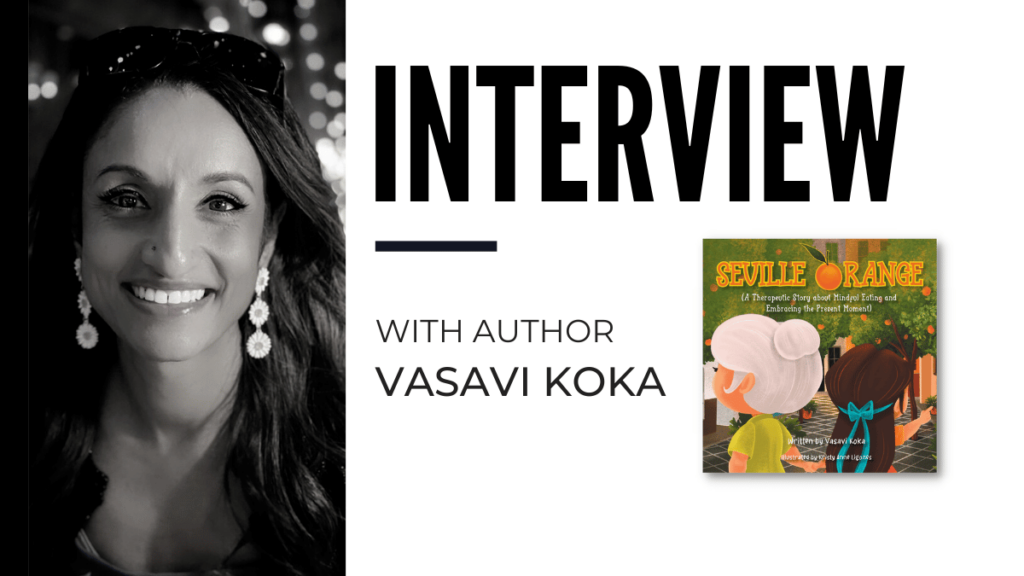An interview about Seville Orange in partnership* with The Children’s Book Review and Vasavi Koka.
Vasavi Koka discusses her latest book, Seville Orange. Through her character Rosa’s family traditions, readers learn about the transformative power of emotions and how they impact relationships. The story promotes emotional intelligence, empathy, and nourishment of the mind and body, inspired by Koka’s experiences and connections to Andalusia, Spain.
Seville Orange utilizes various approaches, like food design and gratitude, to create therapeutic connections and art activities. Meta-emotions are introduced to help children understand and regulate their emotions. Through reading her book, Koka hopes readers reflect on the transformative power of emotions and how they impact lives, relationships, and overall well-being. Read on!
Seville Orange is a thought-provoking story that helps young people by nurturing their intellect and emotional well-being. What should readers expect to discover in your latest book?
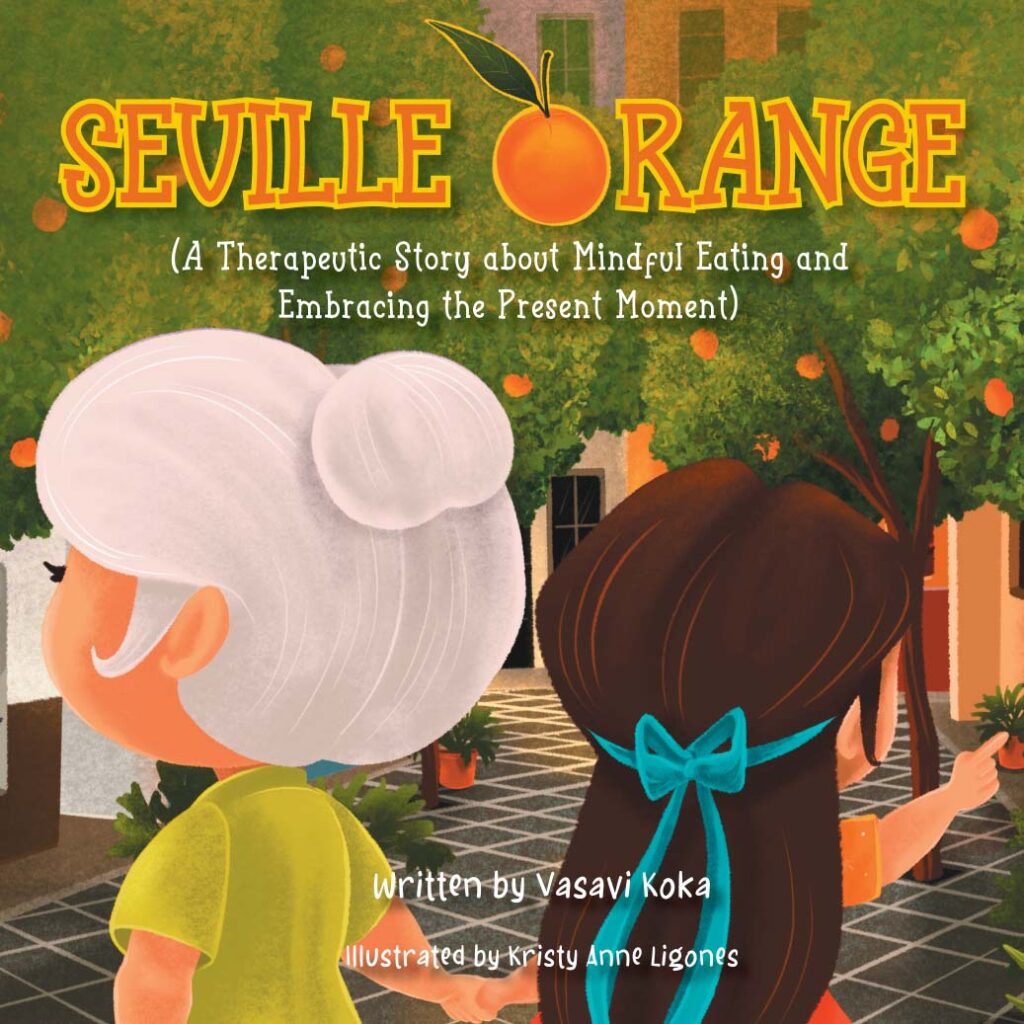
Vasavi Koka: Readers can expect a tale filled with love and wisdom. Through thoughtful illustrations, the grandmother imparts her insight and intuitive wisdom and lovingly demonstrates the inextricable connection between emotions and nourishment, adding layers of meaning and depth to her shared journey with her granddaughter, Rosa. Through the imaginative use of culinary metaphors, “Seville Orange” invites readers to explore the parallels between emotions and food. As the story further unfolds, various feelings come alive through the lens of traditional Andalusian dishes, creating a sensory journey that resonates with young and old alike.
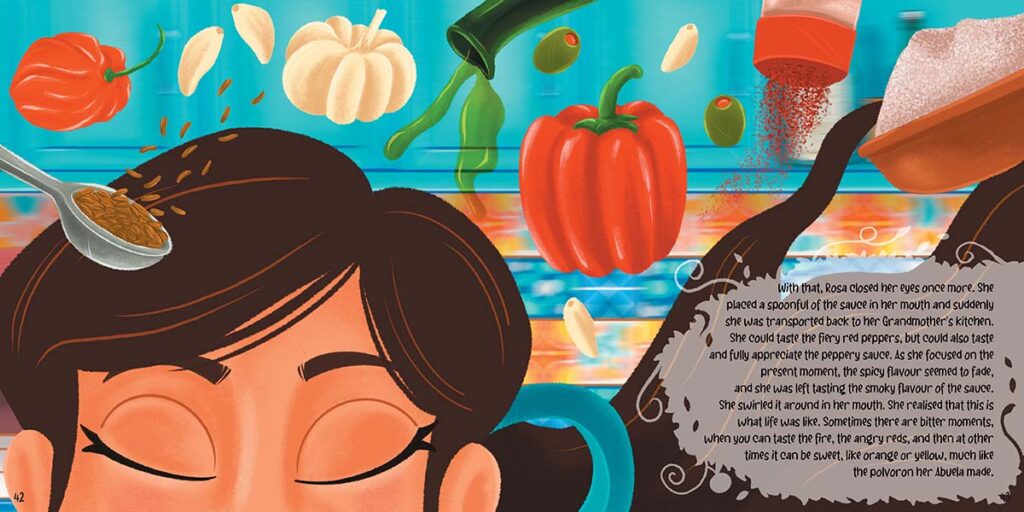
The exploration of food design, gratitude, and mindfulness further enriches the reading experience, empowering readers to find emotional balance and a healthier relationship with food.
Will you share the seed of inspiration for writing Seville Orange? Why is it important to you to teach emotional regulation and a healthier eating approach?
The narrative draws its inspiration from the beautiful relationship between my own mother and my daughter, Iyla. With my mother’s expertise as a chef and restaurant owner, my upbringing was steeped in a world of spices, extraordinary colors, and diverse flavors. Growing up, the scents and tastes that surrounded me painted a rich sensory landscape. Each ingredient my mother cultivated and utilized in her cooking held within it not just sustenance but a storehouse of family tales and wisdom.
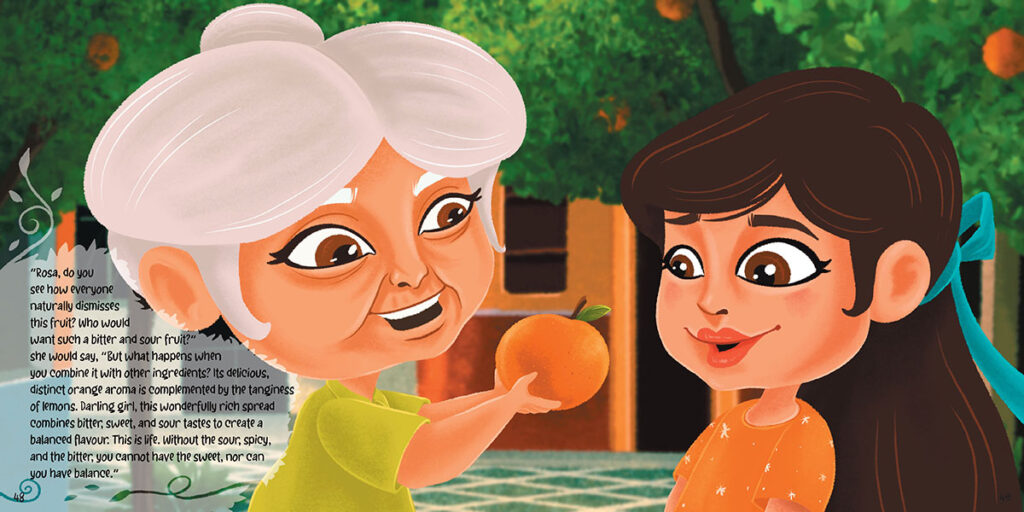
As a child, I found myself enchanted by the stories that lay beneath each recipe. They were not just instructions; they epitomized ancient traditions. The flavors that filled our home were more than just gustatory; they embodied so much more.
With the arrival of my daughter, Iyla, my mother’s culinary artistry took on a new dimension. Every dish she prepared for Iyla was infused with her love and affection, from recipes that she lovingly invented to ones that had been carefully passed down through generations. It was a tangible expression of the profound love she holds for her granddaughter, a way of nurturing and imparting a sense of belonging that transcends generations.
Emotional regulation and healthy eating are both crucial for overall well-being. Emotional regulation involves managing and understanding one’s emotions in a healthy way. Conversely, a balanced and nutritious diet can support emotional well-being. This is thoughtfully conveyed in the therapeutic activity section of my book when readers are shown how emotions can impact eating habits and vice versa.
In ‘The 9 Aspects of Hunger’, children learn how poor emotional regulation might lead to emotional eating, where individuals turn to food to cope with stress or other feelings, often choosing unhealthy options.
Set against the backdrop of Andalusia, Spain, the story revolves around the endearing relationship between a grandmother and her granddaughter, Rosa. What is your connection with Spain, and are these characters based on anyone you know?
I was fortunate enough to spend considerable time traveling through Andalusia. I was spellbound by the amalgamation of decadent art, stunning landscapes, and buildings full of character, and I was keen to convey this in my story. Rosa is inspired by my daughter, Iyla, and her effervescent character. The grandmother’s love for cooking and her affection for Rosa is based on my mother and her endearing relationship with Iyla. It is especially important for me to draw from real-life encounters, interactions, and relationships to create more meaningful narratives.

The book utilizes various approaches, showing parents and educators how they can use food as a vehicle to achieve balance and perspective. What are some of these approaches, and how did you learn about them?
I recently completed a course in ‘Ambitious and Sensory Storytelling,’ which taught me about the importance of engaging the senses and its polyvalent benefits; as Joanna Grace asserts, ‘how and why we engage the senses and how doing so supports cognition, communication, memory, learning, concentration, mental and emotional health, and much more’ (Sensory Projects). This, combined with my therapeutic training, provided the initial catalyst, and I combined this with my intrinsic passion for food. The two seemed naturally synonymous with one another, and once I began combining them, there seemed to be a natural synergy.
Throughout the story, I show readers how food and the process of mindful eating can lead to better emotional health as well as increased psychological well-being. This is explained in the ‘Guide for Grown Ups’ section. In the resources section and in the ‘9 Aspects of Hunger,’ in particular, each of the characters is designed to help children change their relationship with food – equipping them with a greater understanding of why they may turn to food for reasons other than hunger.
Since you emphasize the importance of emotional balance through various food metaphors, can you provide some examples of the food metaphors you’ve used?
The story is enriched with powerful visual and sensory comparisons to food, such as bitter orange, along with various other Andalusian delicacies, such as spicy Mojo picón and flaky, twisted aniseed infused Pestiños. Each of these culinary elements carries its own connections between feelings and tastes, creating parallels between emotional experiences and flavors. The elaborate portrayal is designed to captivate the reader, gaining an insight into the fleeting aspects of emotions as metaphorically symbolized by the delicious yet very different pastries and fiery, piquant sauces.
Readers are introduced to nine whimsical characters following the story and a therapeutic and creative arts section. Each character represents one of the nine aspects of hunger, as identified by Dr. Jan Chozen Bays. Can you share a little about these nine characters and how they and the activities you’ve created help the reader?
Through the creation of these characters, as identified by Dr. Jan Chozen Bays, I hope to teach readers about the importance of validating their emotions and finding healthy ways to regulate and process how they are feeling. The nine aspects of hunger can teach children valuable lessons about life. In many ways, such as:
- The importance of listening to their bodies: By understanding physical hunger, children can learn to recognize when their bodies need food and when they are full.
- The importance of eating a balanced diet: Nutritional hunger teaches children that their bodies need a variety of nutrients to stay healthy and function properly.
- The role of taste in eating: Taste hunger teaches children that food can be enjoyable and that they can develop a taste for healthy foods with practice.
- The role of emotions in eating: Emotional hunger teaches children that they may be tempted to eat when they are feeling stressed, bored, or sad and that it is important to learn how to manage emotions without having to turn to food.
- The importance of mindful eating: Sensory hunger teaches children to pay attention to their food and enjoy the flavors and textures, which can lead to much greater satisfaction.
- The impact of hunger on mood: Mind hunger teaches children that being hungry can affect their mood and behavior, which can impact their relationships with others.
You introduce the concept of meta-emotion. Can you explain what meta-emotions are?
Meta-emotions, in simple terms, are feelings or emotions that we have about our own emotions. It relates to having emotions about how you feel. For example, if you feel happy, you might also feel proud or content about being happy. On the other hand, if you feel sad, you may feel frustrated or upset about feeling sad. Meta-emotions are the emotions we experience in response to our primary emotions. ‘Macario Mango explains Meta Emotions’ is a thoughtful activity that has been carefully designed to help children comprehend and regulate their emotions by providing them with an understanding of the concept of Meta-Emotions.
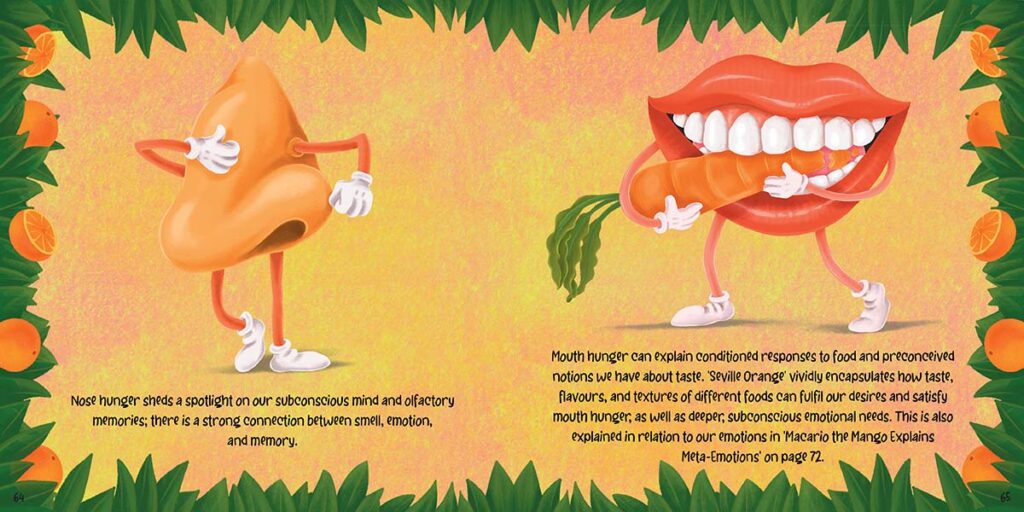
You also explore the playful art of food design and consumption with visual senses. Will you share more about this?
I have always been seduced by the enticing textures and colors found in many foods. The colors, arrangements, and compositions are an area of design that has long fascinated me. This inspired me to embark on several ‘food plating design’ courses, and I spent most of last year learning how to illustrate cultural philosophies within my gastronomic creations. I did this by illustrating the values and traditions of a particular culture through the aesthetic presentation.
I utilize all these experiences to create cathartic art activities such as the artistic food plating activity titled, ‘We Eat with Our Eyes’ that encourages children to explore the visual appeal of food and to be curious about the different elements. When food looks visually appealing, it connects to the idea of ‘eye hunger,’ one of the ‘9 Aspects of Hunger.’
Being fortunate to travel and live in many different places around the world has influenced the way in which I perceive food. During my travels, I learned about cooking in various countries like Japan, Thailand, Morocco, Peru, Ecuador, China, and India. During my time in India and through learning about food from my mother, I realized that there is an extraordinary relationship between food and our senses. The embodiment of different flavors, aromas, texture, visual appeal, tactile sensations, and cultural insights shaped my understanding of how we consume with our senses. Although we may not necessarily realize it.
An example of this is eating Indian food, which traditionally involves using your hands to scoop up food, providing a tactile experience. Feeling the food with one’s fingers can enhance their connection with the meal and teach us that touch can be an essential part of savoring food. I hope my story and complementary activities shed some light on the sensory dimensions of food in our daily lives.
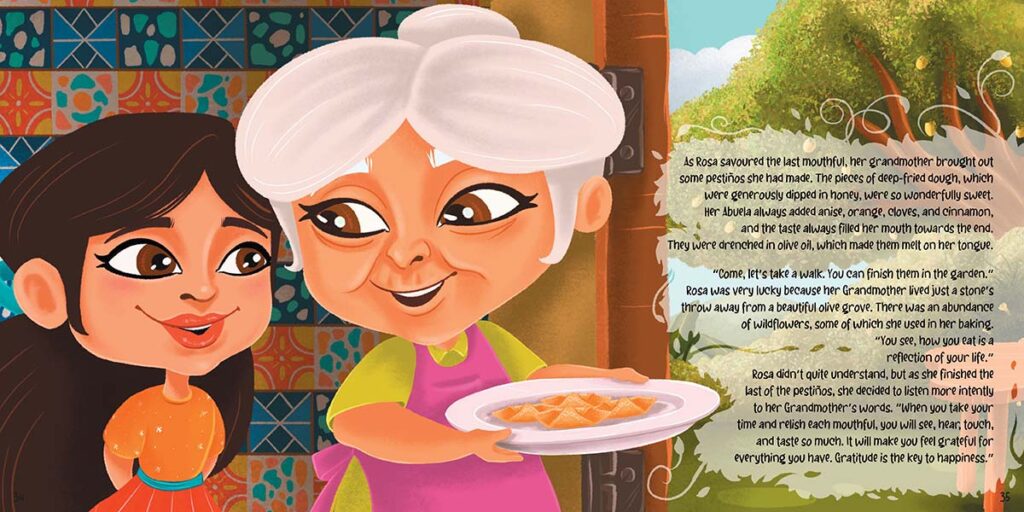
Readers are encouraged to express gratitude for the food they have and the effort that goes into preparing it. Will you share the importance of this?
Gratitude is important for several reasons. It acknowledges the hard work and dedication of those who grow, harvest, cook, and serve the food. In the resources section, in ‘Maria’s Marmalade Meditation,’ children are asked to ‘Observe the connection to nature. Imagine the process of it being grown, the sun and water, the person who picked it, and the person who transported it so you could enjoy it today.” This meditation is designed to make children think and value people that they wouldn’t normally even think about.
Gratitude also promotes mindful eating, which is the backbone of the story. When children are more conscious of the effort that goes into a meal, they are more likely to savor it, eat in moderation, and avoid wastefulness. It also enriches mental well-being. Taking a moment to be more aware, to stay in the present moment, and savor each bite can help cultivate a positive mindset.
When a reader has finished your book, if they were to take away just one thing, what would you want that to be?
‘Seville Orange’ is a therapeutic story that is ultimately designed to help children understand the complex interplay between emotions and daily life. Through the lens of food, it offers a unique perspective on emotional intelligence, empathy, and the power of love and wisdom passed down through generations. Grown-ups can use it as a starting point for discussions about emotional awareness, the way in which we communicate as well and the importance of nourishing our emotional well-being.
My one takeaway would be to encourage readers to reflect on the emotions they experience and the impact these emotions can have on their lives, relationships, and overall well-being. Through captivating illustrations, mouth-watering descriptions, and tantalizing food metaphors, readers are offered a fresh and creative way to engage with the concept that our emotional experiences are as important and transformative as the ingredients that make up our delicious meals.
For more information, visit https://ropanastories.com/.
About the Book

Seville Orange: A Therapeutic Story About Mindful Eating and Embracing the Present Moment
Written by Vasavi Koka
Illustrated by Kristy Anne Ligones
Ages 9+ | 117 Pages
ISBN-13: 9798861600507
Publisher’s Book Summary: Seville Orange is a therapeutic story that encapsulates the complexities of different emotions through the metaphor of food. It follows the story of Rosa and her relationship with her grandmother. Rosa’s grandmother teaches her the importance of validating her emotions and accepting that life is a combination of multiple flavors that must be embraced in order to achieve balance in life. The book is designed to help children aged between 9-12 and also contains a selection of therapeutic activities which will help children explore their emotions through play and creativity. It is the second story and activity pack in Ropana Stories.
Buy the Book
This interview—Vasavi Koka Talks About Seville Orange: A Therapeutic Story about Mindful Eating and Embracing the Present Moment—was conducted between Vasavi Koka and Bianca Schulze.

